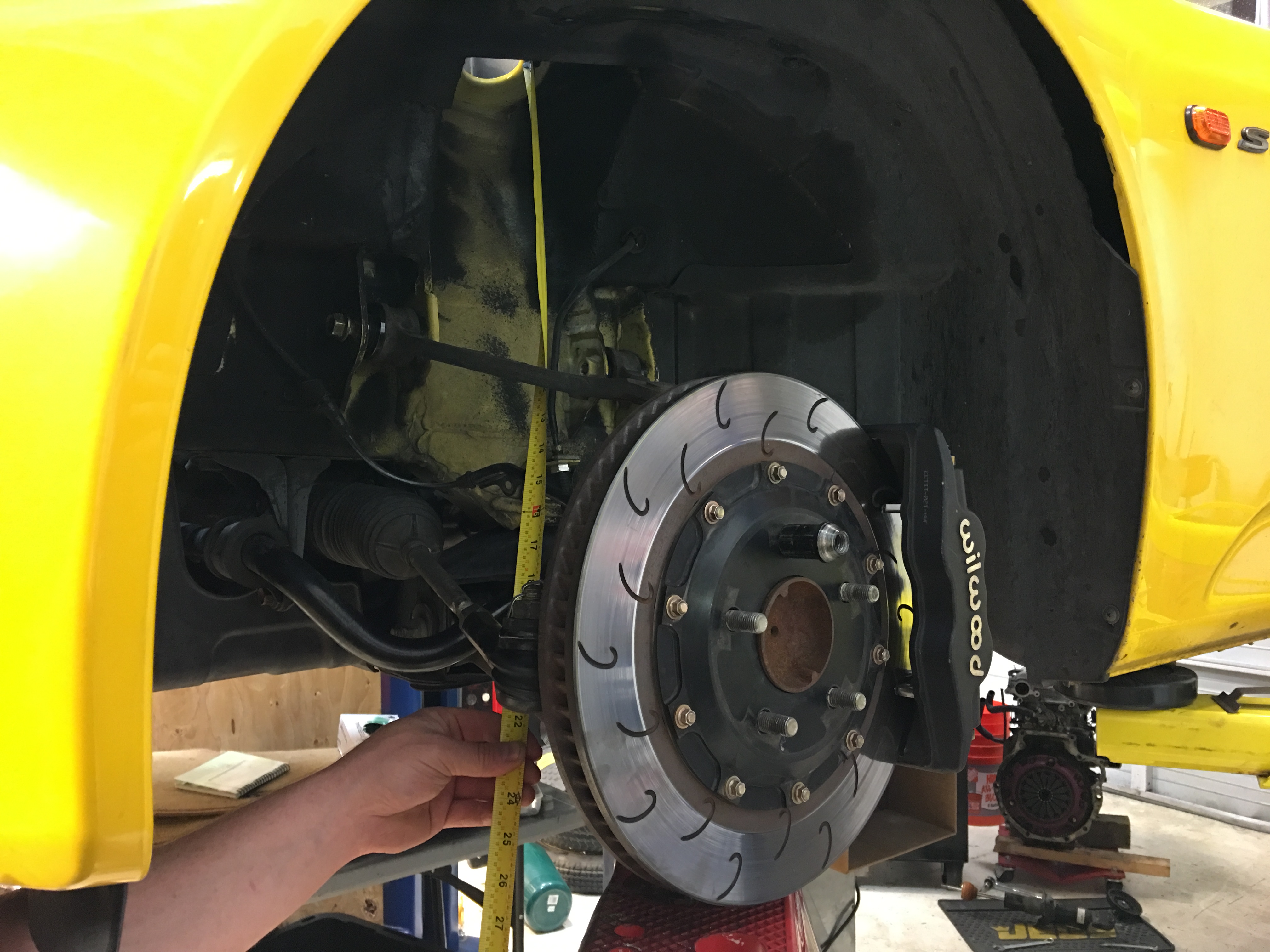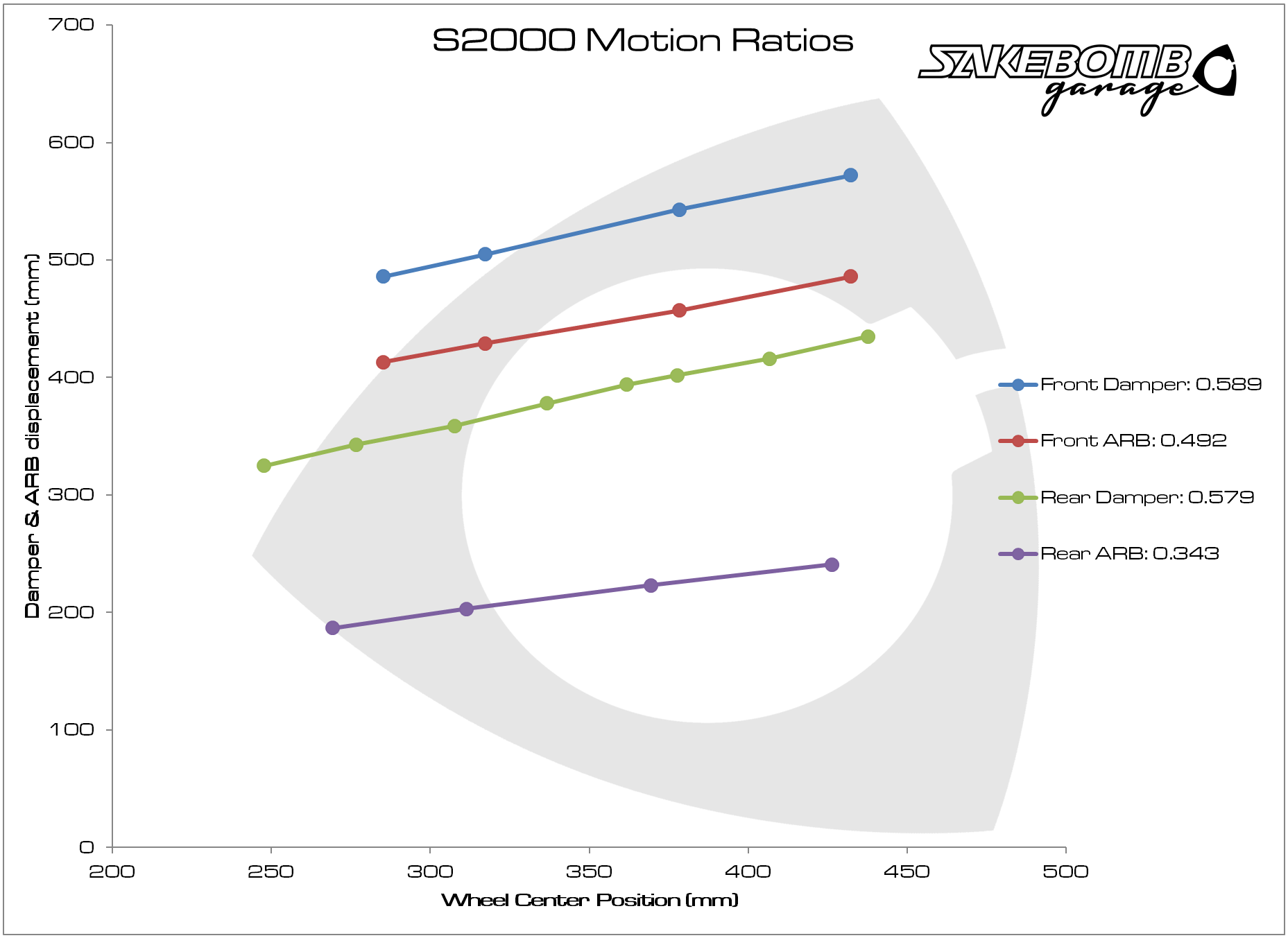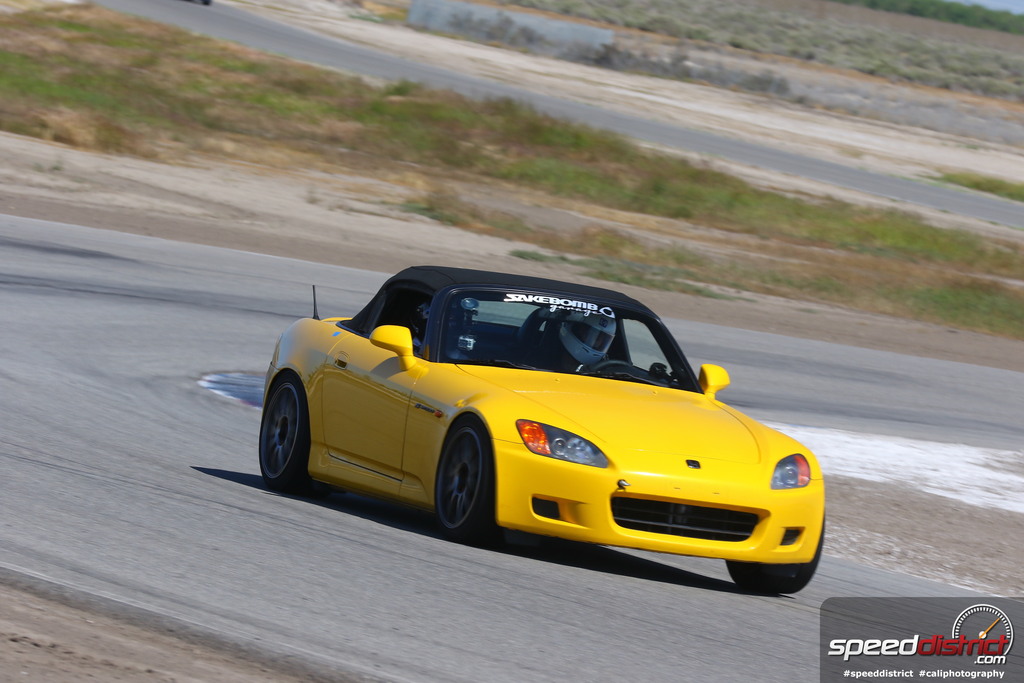The Actual S2000 Suspension Motion Ratios
#1

During recent developement we noticed a lot of disagreement within the community as to what the S2000 damper and anti-roll bar motion ratios are. A lot of people are calculating motion ratios using lever lengths of the lower control arm and damper angle correction values. This is easy way to get approximate values but clearly doesn't get very consistent results based on what we've seen.
-----------------------------------------------------------------------------------------------
Motion Ratio is defined as Damper Travel/Wheel Travel and to get more accurate results we went ahead and measured this directly.

While we were at it we also measured the anti-roll bar motion ratios are.

Damper motion ratios are: 0.589 Front and 0.578 Rear
ARB motion ratios are: 0.492 Front and 0.343 Rear
Now that motion ratios are known, we can generate some wheel rate conversion factors:
Wheel rate = Spring Rate * MR^2
Front Wheel Rate = Front Spring Rate * 0.347
Rear Wheel Rate = Rear Spring Rate * 0.334
-----------------------------------------------------------------------------------------------
Some people find the MR^2 confusing, the reason the squared is there is because the MR is applied to both the force side of things and the travel side of things. This also means that the accuracy of the motion ratio very important as any error in the number is squared.
When vertical load is applied on the tire,
Damper Load = Wheel Load / MR
Then the damper deflects,
Damper Travel = Damper Load / Spring Rate
The the wheel travels due to the damper travel,
Wheel travel = Damper travel / MR
Wheel rate is the force per wheel travel,
Wheel Rate = Wheel Load / Wheel Travel
Wheel Rate = (Damper Load * MR) / (Damper Travel / MR)
Wheel Rate = Damper Load / Damper Travel * MR^2
Wheel Rate = Spring Rate * MR^2
-----------------------------------------------------------------------------------------------
Hopefully this will help with everyone's coilover setup. Feel free to reply here or send us a PM with any questions.
Stay tuned for more information and for some exciting upcoming product announcements!
-SBG

__________________
SAKEBOMB GARAGE > Click here to contact Us
Check some of our most popular products for the S2000:
- Ohlins DFV Billet Lower Mount
- Rear BBK RX-8 Caliper Conversion
- Front BBK AP Competition
- Setrab Oil Cooler Kit
SAKEBOMB GARAGE > Click here to contact Us
Check some of our most popular products for the S2000:
- Ohlins DFV Billet Lower Mount
- Rear BBK RX-8 Caliper Conversion
- Front BBK AP Competition
- Setrab Oil Cooler Kit
#2
This is good info. To let everyone know, there is a bit of discussion about this in the Racing and Competition subforum.
Also, perhaps this should be a sticky, just under the sticky thread:
Characterization of the OE Suspension Springs Coil springs and stabilizer bars
https://www.s2ki.com/...ension-springs/
Also, perhaps this should be a sticky, just under the sticky thread:
Characterization of the OE Suspension Springs Coil springs and stabilizer bars
https://www.s2ki.com/...ension-springs/
#5
So can someone take this and elaborate on how it can be used to select spring rates for the S2000? I recall a discussion I had a while back, but it has been too long and I filled my brain with other useless information!
#6
So ultimately the motion ratio is used to find the wheel rate for a given spring rate. The wheel rate is the effective vertical stiffness at the actual wheel. Every car has a different motion ratio so the spring rate is ultimately not helpful unless you are comparing to other cars of the same make and model. For instance another car we are developing currently is the ND Miata, the rear motion ratio is ~0.86 which means a 10kg/mm spring has a wheel rate of 7.4kg/mm. The same spring on the rear of the s2k results in a wheel rate of 3.3kg/mm. The same spring on the mMiata results in a suspension that is 2.2x stiffer than the s2000.
Additionally the weight of the car has an effect, A wheel rate of 3kg/mm on the s2000 is somewhat stiff but on an SUV it would very soft. This is because the spring has to deal with significantly more mass so the stiffness feels like it is lower. The Ride Natural Frequency captures the ratio of wheel rate to vehcile mass.
Ride Natural Frequency = SquareRoot( Wheel Rate / Unsprung Mass) where unsprung mass is the unsprung mass supported by the corner of the car in question.
Luxury sedans are generally 0.5 - 1.0 hz
Typical sports cars run between 1.0 - 1.5 hz
Track cars without lots of underbody aero 1.5 - 2.5 hz
Race cars are often 4.0+ hz depending on aero requirements.
Additionally the weight of the car has an effect, A wheel rate of 3kg/mm on the s2000 is somewhat stiff but on an SUV it would very soft. This is because the spring has to deal with significantly more mass so the stiffness feels like it is lower. The Ride Natural Frequency captures the ratio of wheel rate to vehcile mass.
Ride Natural Frequency = SquareRoot( Wheel Rate / Unsprung Mass) where unsprung mass is the unsprung mass supported by the corner of the car in question.
Luxury sedans are generally 0.5 - 1.0 hz
Typical sports cars run between 1.0 - 1.5 hz
Track cars without lots of underbody aero 1.5 - 2.5 hz
Race cars are often 4.0+ hz depending on aero requirements.
__________________
SAKEBOMB GARAGE > Click here to contact Us
Check some of our most popular products for the S2000:
- Ohlins DFV Billet Lower Mount
- Rear BBK RX-8 Caliper Conversion
- Front BBK AP Competition
- Setrab Oil Cooler Kit
SAKEBOMB GARAGE > Click here to contact Us
Check some of our most popular products for the S2000:
- Ohlins DFV Billet Lower Mount
- Rear BBK RX-8 Caliper Conversion
- Front BBK AP Competition
- Setrab Oil Cooler Kit
Trending Topics
#8


Depends on where you want more roll resistance.
Typically, people opt for square rates or slightly front-heavy rates.
Most agree that you want more roll resistance up front.
Typically, people opt for square rates or slightly front-heavy rates.
Most agree that you want more roll resistance up front.
#9


There are a lot of other considerations as well.
Calculations don't tell you what to do. That's not their direct purpose. They just tell you how it is.
Calculations don't tell you what to do. That's not their direct purpose. They just tell you how it is.
#10
Yeah, I actually went more front bias currently (525/440), but I have some swift springs in the basement that are going on (550/500). I just wanted to be sure there wasn't some reason, based on this to consider a different bias, but I think the 550 will go on the front.



